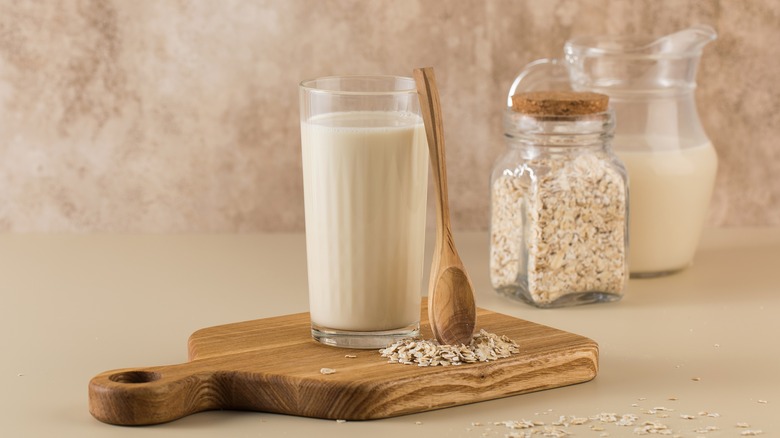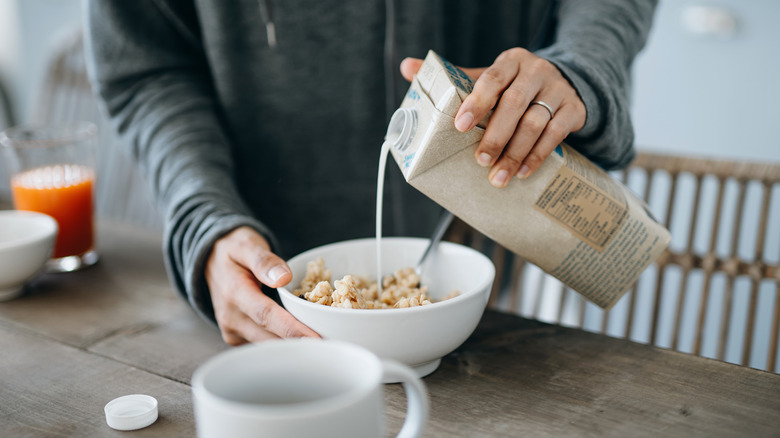How Long An Open Container Of Oat Milk Will Last In The Fridge
Although plant-based milks are nutritious, tasty, and can function in recipes the same way as traditional dairy would, they're obviously different from both dairy milk and each other. Each type of plant milk has its own flavor, nutritional profile, and of course, shelf life. Pasteurized cow's milk, stored unopened in the refrigerator, has a total shelf life of about three weeks. Once opened, it can last up to seven days in the refrigerator before it starts to spoil. Most plant milks last a bit longer than this, including oat milk.
Store-bought oat milk will last up to 10 days in the refrigerator after opening, but if you don't open it, it can last up to a whopping four months. Of course, you should always check the label on your particular carton of milk, as it will tell you how long you can store the milk both opened and unopened. Either way, it's likely that you have a long-lasting product on your hands, so long as you keep it sealed until you need it.
That being said, timelines change dramatically when it comes to homemade oat milk. As you might expect, the homemade stuff has a much shorter shelf life than its store-bought counterparts — only about five days, at the most. After all, it hasn't been treated with preservatives, and it's considered an "opened" product, no matter the container you store it in. Luckily, if you suspect it's past its prime, it's easy to figure it out for sure.
Signs that your oat milk has gone bad
Like any other type of milk, oat milk spoils over time. Sure, the sell-by and use-by dates can offer some hint as to when spoilage might occur, but these dates don't necessarily tell you when the milk is unsafe to consume. Your best bet is to rely on your senses to determine if you should drink it or not. This includes all your senses — for instance, if the milk smells fine, but looks off, you shouldn't put more value into its appearance and assume it's okay to drink.
One telltale sign of spoilage is bloated packaging, caused by bacteria that release gasses as they multiply. You might also notice a sour smell when you open the carton, though it's not uncommon for oat milk to lack this particular trait. As such, you should also assess the color of the milk. If the milk has taken on a yellowish color (or any abnormal color, for that matter), it's going bad.
Lastly, you can check the milk's texture by pouring some into a glass. Spoiled milk is often thicker or even clumpy in consistency. Hopefully this would go without saying, but do not drink chunky milk, even if the milk is supposedly still within its best-by date. Thorough observation is the way to go in order to avoid foodborne illness.
Savor your oat milk's shelf life via proper storage
As mentioned previously, oat milk has a longer shelf life than cow's milk, but only if stored in the proper conditions. Shelf-stable cartons of oat milk — which you buy outside of the refrigerated section at the store — do not have to be refrigerated, and can instead be kept somewhere cool away from direct sunlight. If you buy oat milk from the fridge, though, store it in the fridge from the start. Once opened, oat milk needs to be refrigerated at a temperature at or below 40 degrees Fahrenheit. Since the refrigerator door is the one place you shouldn't store milk, you should instead keep it at the back of the fridge, preferably on the bottom shelf.
You can also limit bacterial contamination by tightly resealing the milk in between uses. You should try to avoid touching the opening of the carton or container with your hands, and never drink directly from the container, as this introduces germs. Instead, always pour milk into a cup, which also allows you to see the milk's color and texture before you take a drink. After all, who wants to unknowingly drink chunky milk? Not us.



